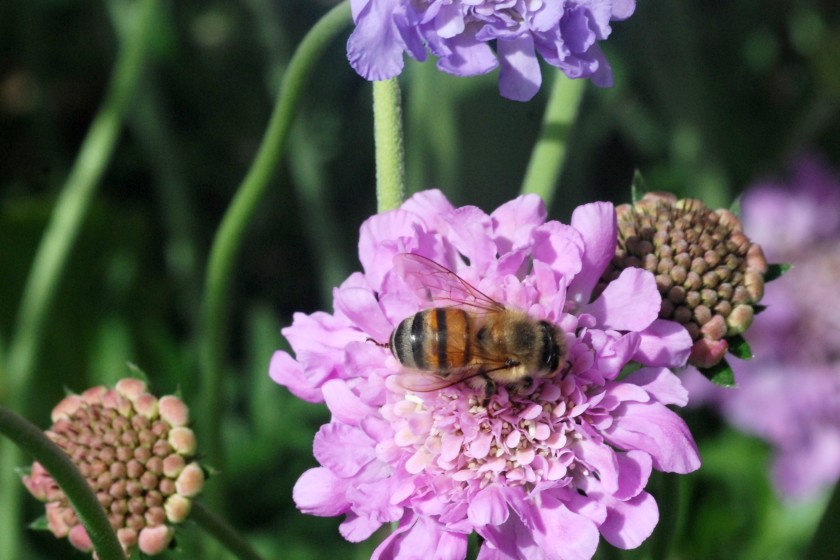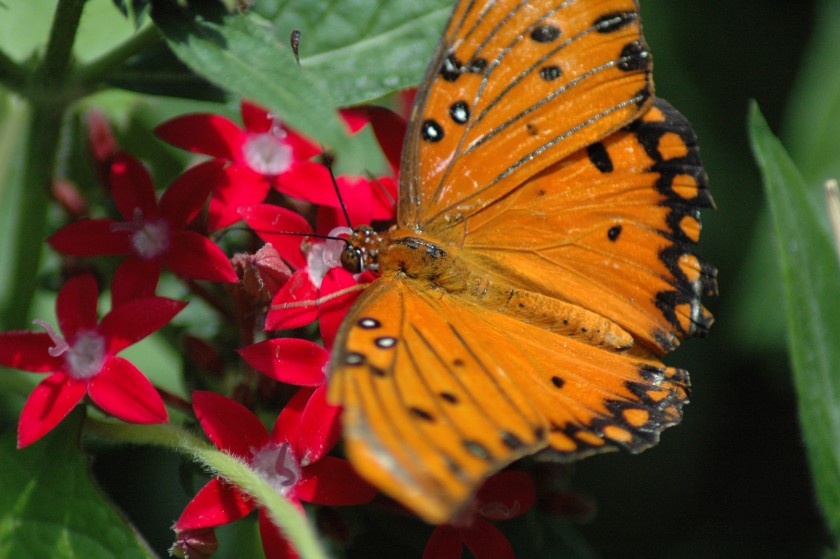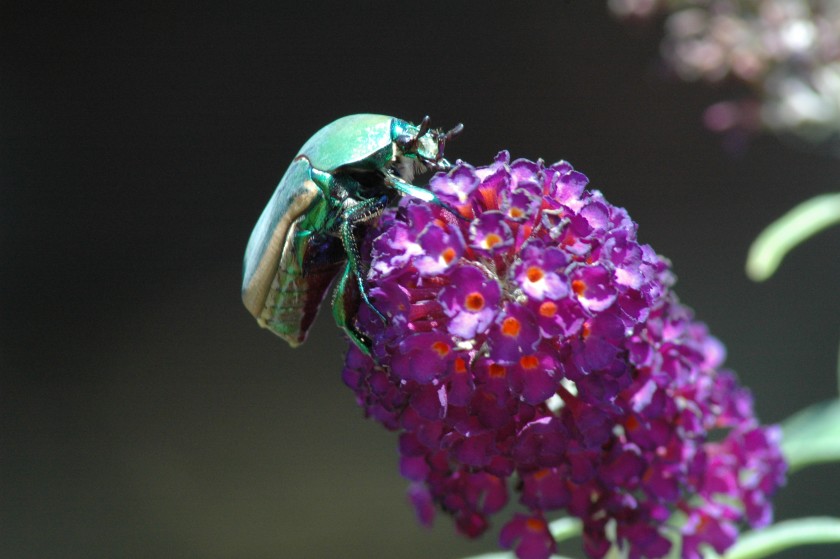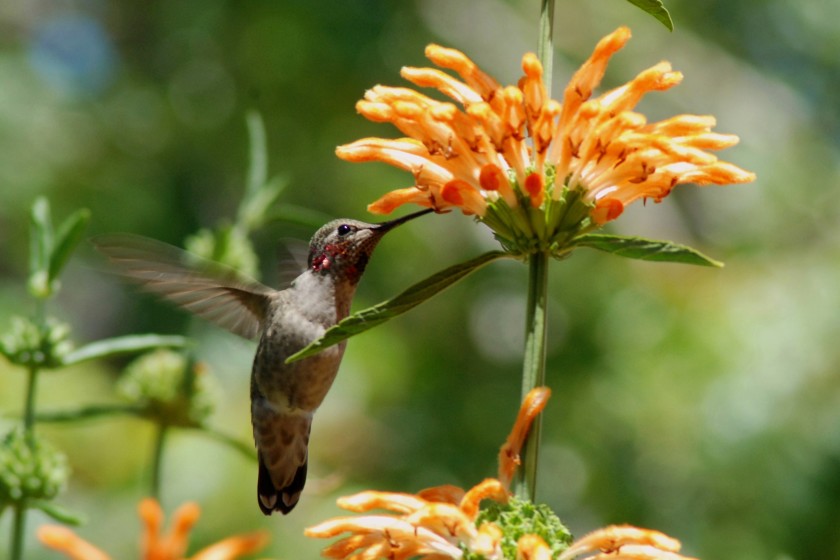Plant for the pollinators, which keep our world buzzing with life
By Jodi Bay
(This article originally appeared in the San Diego Union-Tribune - Mar 13, 2021)

A bee pollinates a pincushion flower.(Meredith French)
“If the bee disappeared off the surface of the globe, then man would have only four years of life left. No more bees, no more pollination, no more plants, no more animals, no more man.”
ALBERT EINSTEIN
Ah, Spring! The flowers are in bloom, rich in color and scent. Fruit and vegetable crops are showing the beginnings for future harvest. All this beauty and bounty is dependent on a mechanism without which there would be no flowers, fruits, seeds or even plants. That mechanism is called pollination, the process of transferring pollen from male to female flower.
Pollen is a powdery substance, found in the stamen of a male flower, that contains the cells necessary for reproduction. Pollination is the transfer of pollen from the anther (male part) to the stigma (female part) of the flower on the same or different plant. When the pollen grain deposits on the stigma, it germinates and migrates into the embryo sac, where fertilization occurs.
The vehicles that transfer pollen from anther (male) to stigma (female) can be through self-pollination (internal transfer of pollen to stigma) or through what are called pollinators, primarily insects, animals or wind. The process of pollination gives us much of the food we eat and the flowers we enjoy.
There are several types of pollinators:
- Bees are the most important pollinators, with 35 percent of the food we eat having been pollinated by bees. The European honeybees (Apis mellifera) are the most well known bees for the honey they provide. There are around 20,000 bee species worldwide and 1,600 native to California. Additionally, cutter bees (Megachile spp.) are important native pollinators of North America.You can invite all bees into your garden by giving them a place to live, food and water. Many native bees live in the ground in burrows or hollow stems. Leaving stems in the garden from flowering plants like bee balm attracts and provides shelter to native bees.Unlike other insects that derive water from plants, bees need water from an external source. Place a shallow pan lined with rocks and filled with water in the garden. Bees cannot swim and the rocks provide a place to rest while accessing the water. Change the water regularly, as stagnant water is a breeding site for mosquitoes.
- Butterflies and moths catch pollen on their legs and transfer it from flower to flower. Each species of butterfly or moth seeks specific plants for nectar or habitat. Moths are distinguished from butterflies by their wider bodies, less colorful wings, and as nighttime flyers.

A Gulf Fritillary butterfly on Pentas.(Meredith French)
- Hummingbirds are the most important pollinating bird in North America. They have no sense of smell and seek brightly colored flowers with curved petals that provide easy access to nectar. Hummingbirds use their long tongue to lap nectar, and pollen attaches to their beak. As hummingbirds travel from flower to flower, they transfer pollen between plants.
- Bats are nighttime pollinators that pollinate many plants of the Southwest, such as agave and cactuses. They play a role in pollination of edibles such as bananas, avocados and cashews. Bats prefer light-colored flowers that are open at night.
- Other insects such as hover and bee flies, and beetles are generalist pollinators, visiting a wide variety of plants.
- Wind pollinates about 12 percent of the world’s flowering plants, trees and some edibles. Wheat, rice, corn, barley, rye and oats are some of the grasses that can be self-pollinated but also utilize biotic and abiotic (wind) pollinators. Additionally, many nut trees, such as walnuts, pecans and pistachios, as well as some hardwood trees such as fir and pines, rely on wind for pollination.

A beetle pollinates a butterfly bush.(Meredith French)
Pollinators are attracted to flowers by their color, shape, size and scent. Each pollinator type has different needs. Master Gardener Peggy Kenney, a pollinator specialist, recommends planting a diverse mix of flowering plants so that something is blooming all four seasons. Plant varieties native to your local area, because pollinators are better adapted to native plants. Some seek specific plant varieties.
Also, allow the garden to go wild. Gardens with leaves on the ground and a few weeds mimic more natural habitat and encourages pollinators.
For a list of plants that attract specific pollinators, read the article, “How to Attract and Maintain Pollinators in Your Garden.”
A tip for vegetable gardeners is to mix flowers in vegetable beds at the same time the vegetable garden is planted to increase biodiversity of plants. Early blooming plants attract pollinators just in time to pollinate the vegetables.
However, pollinators can be at risk. Their numbers have been declining due to habitat loss, drought and parasites such as the Varroa mite, fungi, viruses and exposure to pesticides. Reducing or eliminating the use of pesticides is one way home gardeners can improve conditions for pollinators. At all times, look for alternatives to pesticides or select pollinator-friendly products, and follow the Integrated Pest Management guidelines to a healthy garden.

A hummingbird gathers nectar from Lion’s tail (Leonotis spp.).(Meredith French)
More information on pollinator safety can be found at UC Statewide IPM Program, http://ipm.ucanr.edu.
In addition, when purchasing plants for your garden, ask if the plant was sprayed with pesticides at any time. Systemic pesticides are absorbed by plant tissue, resulting in the nectar and pollen becoming toxic to pollinators. The result might be inadvertent harm to the pollinators and other beneficial insects.
Attract pollinators to your garden by adding pollinator-friendly plants and reducing or eliminating pesticide use. The result will be a thriving garden filled with color, scent, life and beauty.
Jodi Bay, a UCCE Master Gardener since 2012, is an instructor in the Beginning Vegetable Gardening workshops. Get free gardening advice on the Master Gardener Hotline, (858) 822-6910, or by email at help@mastergardenersd.org. Due to COVID-19, the Master Gardener Hotline staff members are working remotely to ensure they respond to your questions in a timely manner.

